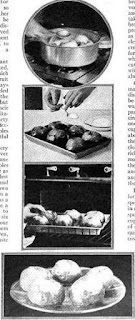APPLE a day keeps the doctor away," goes the old saw so familiar to us all, but whether that prescribed apple shall be or raw is left to our own disA well-baked apple served daintily for breakfast, or as a complement to a good luncheon or dinner, is hard to surpass from both a dietetic and a savory standpoint.
The choice of apples is a most important one to insure the fluffy, crimson-cheeked, translucent globes of deliciousness which I have in mind. Large, well-flavored fruit that will not easily fall to pieces is always preferable. If the recipe calls for peeled apples, the outward appearance of the raw fruit is not of great moment, but when the apples are to be baked in their peels, I should advise King apples, Spitzenburgs, or any other bright red variety which is of good flavor and very firm texture. The spotty fruit and smaller apples may be served in many other delightful ways.
Baked Apples Glace are merely very good baked apples, but they have never failed to awaken admiration in every one who has seen or eaten them. These apples may be made as plain or as elaborate as one desires. Select the largest and reddest firm apples that you can find, and core and peel them about one-third of the way down from the stem end; then place them in a deep dripping pan or casserole which has a closely-fitting cover. Meanwhile make a thin sirup, using one cupful of sugar to one and one-half cupfuls of water for six apples, and boil it for six minutes. Pour this sirup over the apples, cover them tightly, and place in a medium hot oven, or over a low gas burner flame. Baste the apples occasionally until they arc quite tender, but still whole and perfect. Remove the cover and place one teaspoonful of sugar in the cavity of each apple, also sprinkling sugar over the peeled surface. Then place the pan under the flame.
Place the pan under the broiler flame or in a hot oven until the sugar has melted and the apples have a delicate plazed appearance THE making of pies seems always to have been the bugaboo of cooking. It is discouraging to the housewife to serve a misshapen pie, or one whose crust is pale and soggy, and it is safe to say that pie-making brings forth more disparaging remarks than any other kind of cookery, so the young housewife is especially loathe to attempt it. Yet an analysis of the whole process of plain pie-making proves it to be a comparatively simple one and one which, if carefully followed, brings forth almost faultless results.
Bibliographic information Title: Good Housekeeping, Volume 70 Publisher: Hearst Corporation, 1920. Original fromL: University of Minnesota. Digitized: Mar 30, 2011
skip to main |
skip to sidebar
"Always remember there are no kitchen mistakes---only opportunities for new recipes"
Popular Recipes Posts
-
From Chitlin Strut.com "I am not a Chitlin' eater; But a Chitlin' eater's son. Someone else can eat de Chitlin's 't...
-
Carrot Cake ~ "Carrots have been used in sweet cakes since the medieval period, during which time sweeteners were scarce and expensive,...
-
Fa gao (simplified Chinese: 发糕; traditional Chinese: 發粿; Pe̍h-ōe-jī: hoat-koé) is a Chinese cupcake-like pastry, most commonly consumed on t...
-
Kishke also known as stuffed derma, is a Jewish dish traditionally made from beef intestine (casing) stuffed with flour or matzo meal, schma...
-
Oxtail (occasionally spelled ox tail or ox-tail) is the culinary name for the tail of cattle. Formerly, it referred only to the tail of an o...
-
Crab Benedict aka Eggs Neptune is a twist on the dish known as Eggs Benedict using crabmeat in place of ham. In the U.S. there are 7 grade c...
-
" abob, kabob (ka-bob'), kabaub, kibaub. n.Roast meat. A dish consisting of small pieces of beef or mutton, seasoned with pepper, s...
-
"In the U.S. and Canada, consumption of corned beef is often associated with Saint Patrick's Day. Corned beef is not considered an ...
-
Recipe For ~ Angel's Food Cake: 11 eggs (whites) 1 1/2 cupfuls granulated sugar 1 cupful flour 1 teaspoonful vanilla or almond. 1 teaspo...
-
In the United States, the term "pigs in a blanket" often refers to hot dogs, Vienna sausages, cocktail or breakfast/link sausages ...
Recipes Privacy Policy
Powered by Blogger.
Leaderboard
About Me
Recipes Google +1
Like Our Content? Please Give Us a +1. Thanks!
Add This Site Share
.
Followers Recipes Damage In The Kitchen
About Recipes Damage In The Kitchen
| i've always enjoyed cooking and baking and was fortunate to have been raised in an environment that fostered a love and respect for food.
The title "Recipes Damage In The Kitchen" is a wink to the expression 'to make an omlette you've got to break a few eggs' and a nod to everyone i've learned from---family, friends, and professionals in the food industry about creating one of the most essential things one person can give to another---a good meal. And of course when creating a good meal you're gonna have some damage in the kitchen. |












No comments:
Post a Comment